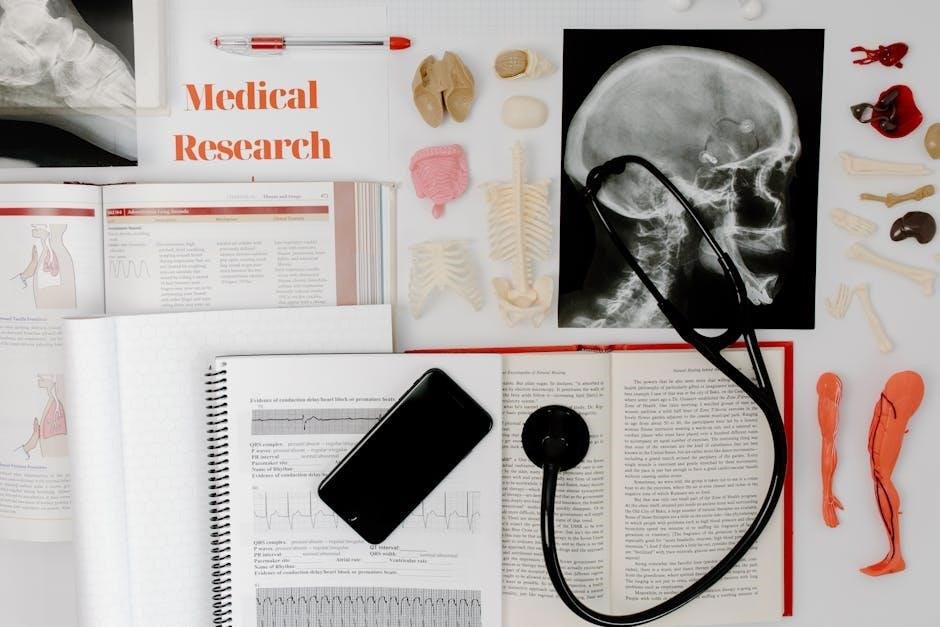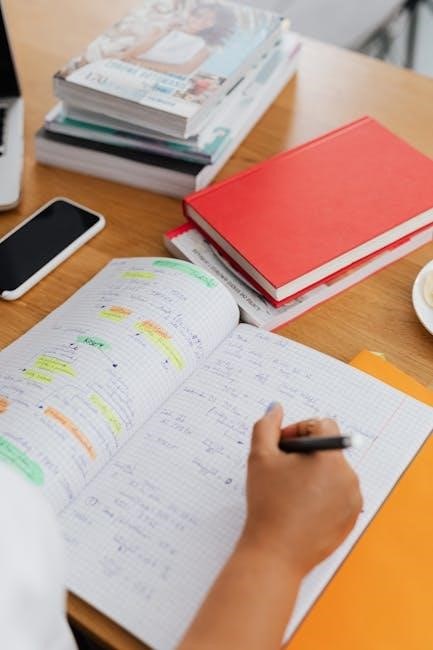Year 7 maths textbooks are essential resources for students transitioning to higher-level mathematics. They provide structured content, covering key topics like number operations, algebra, and geometry. These books often include step-by-step explanations, practice exercises, and interactive elements to engage learners. PDF formats make them easily accessible and convenient for modern students.
1.1 Overview of Year 7 Mathematics Curriculum
The Year 7 mathematics curriculum is designed to build foundational skills in key areas, including number, algebra, geometry, and statistics. It introduces students to more complex concepts, such as place value, fractions, and decimals, while reinforcing basic arithmetic operations. Algebraic expressions and patterns are explored to develop problem-solving abilities. Geometry focuses on understanding shapes, angles, and spatial reasoning, while statistics involve collecting, interpreting, and presenting data. The curriculum emphasizes critical thinking and practical applications of mathematical concepts to real-world scenarios. It also encourages the development of logical reasoning and communication skills, preparing students for more advanced studies in mathematics.
1.2 Importance of Using Textbooks in Maths Education
Textbooks play a crucial role in maths education by providing a structured and comprehensive learning path for students. They ensure that key concepts are introduced progressively, building on previously learned skills. Maths textbooks offer a reliable source of information, vetted by educational experts, which helps students and parents trust the content. They also include practice exercises, examples, and visual aids, making complex ideas more accessible. Textbooks promote independent learning, allowing students to review and practice at their own pace. Additionally, they serve as a consistent reference point for teachers, ensuring alignment with curriculum goals. The availability of maths textbooks in PDF formats further enhances accessibility, making high-quality educational resources reachable for a wider audience.
1.3 Benefits of PDF Format for Textbooks
The PDF format offers numerous advantages for Year 7 maths textbooks, enhancing accessibility and convenience for students. PDFs are easily downloadable and can be accessed on various devices, including tablets, smartphones, and computers, making learning flexible. They maintain consistent formatting across platforms, ensuring that equations, diagrams, and layouts remain clear and intact. PDFs also support interactive features like hyperlinks and search functions, which aid in navigation. Additionally, they are cost-effective and environmentally friendly, reducing the need for physical copies. Schools and students can store multiple textbooks digitally, saving space and resources. The PDF format is also shareable, allowing easy distribution among students and educators, fostering collaborative learning and accessibility for all.

Popular Year 7 Maths Textbooks Available in PDF
Popular Year 7 maths textbooks in PDF include ICE-EM Mathematics Year 7, Cambridge Lower Secondary Mathematics, and Year 7 Essential Maths AC, offering comprehensive content and exercises.
2.1 ICE-EM Mathematics Year 7 Third Edition
The ICE-EM Mathematics Year 7 Third Edition is a widely used textbook designed for students transitioning to secondary school; It aligns with the Australian Curriculum, focusing on foundational maths skills. The textbook covers key topics such as number, algebra, geometry, and statistics, providing a comprehensive learning experience. With interactive layouts and clear explanations, it engages students and supports their understanding. Practice exercises and real-world examples help reinforce concepts, making it an ideal resource for Year 7 learners. Available in PDF format, it offers convenience for digital learning, accessible via downloads from publishers or educational platforms. This edition is praised for its structured approach and effectiveness in building maths confidence.
2.2 Cambridge Lower Secondary Mathematics Learner Book 7
The Cambridge Lower Secondary Mathematics Learner Book 7 is a comprehensive resource designed for students following the Cambridge International Curriculum. It covers essential topics such as number, algebra, geometry, and statistics, with a focus on building problem-solving skills. The book features colourful illustrations, clear explanations, and engaging activities to make learning maths enjoyable. Practice exercises are included to reinforce concepts, and answers are provided to help students assess their progress. Available in PDF format, this textbook is easily accessible and compatible with digital devices. Its structured approach and interactive elements make it an excellent choice for Year 7 students aiming to master foundational maths skills. The curriculum-aligned content ensures a smooth transition to higher-level mathematics.
2.3 Year 7 Essential Maths AC for Australian Curriculum
The Year 7 Essential Maths AC textbook is specifically designed for students following the Australian Curriculum. It provides a comprehensive coverage of key maths topics, including number, algebra, geometry, and statistics. The textbook is structured to support both classroom learning and independent study, with clear explanations and practical activities. Available in PDF format, it offers flexibility for digital learning. The content is aligned with the Australian Curriculum standards, ensuring students develop essential maths skills. Interactive elements and real-world applications make learning engaging. This textbook is a valuable resource for Year 7 students, helping them build a strong foundation in mathematics while meeting curriculum requirements. It is widely used in Australian schools and is praised for its clarity and effectiveness.
2.4 Cambridge Checkpoint Maths Student Book 7
The Cambridge Checkpoint Maths Student Book 7 is a comprehensive resource designed for students following the Cambridge Lower Secondary curriculum. It covers essential mathematical concepts, including number, algebra, geometry, and statistics, with a focus on developing problem-solving skills. The textbook is structured to promote gradual progression, with clear explanations and practical exercises. Available in PDF format, it offers flexibility for digital learning, allowing students to access content anytime, anywhere. The book is part of a well-known series trusted by educators worldwide, ensuring a high standard of mathematical education. Its interactive and engaging layout makes learning enjoyable, while the inclusion of answers and solutions supports self-assessment. This textbook is ideal for students preparing for Cambridge Checkpoint exams and beyond, providing a solid foundation for future mathematical studies.

Structure and Content of Year 7 Maths Textbooks
Year 7 maths textbooks are structured around core topics like Number, Algebra, Geometry, and Statistics. Each chapter includes clear explanations, practical exercises, and real-world applications to build foundational skills progressively.
3.1 Number and Place Value

Number and Place Value form the foundation of Year 7 mathematics, focusing on understanding the value of digits in different positions. Students learn to interpret and compare large numbers, including those with up to six digits. Key topics include place value in whole numbers and decimals, rounding numbers to the nearest thousand, and performing mental calculations for quick estimates. The curriculum also covers ordering and comparing numbers, ensuring students grasp numerical relationships. Practical exercises in PDF textbooks provide opportunities to apply these concepts, such as arranging numbers in ascending order and solving real-world problems involving measurements and financial calculations. These skills are essential for building a strong numerical foundation.
3.2 Algebra and Patterns
Algebra and Patterns introduce students to the fundamentals of mathematical relationships and logical reasoning. Topics include recognizing and creating patterns, understanding algebraic expressions, and simplifying equations. Students learn to identify and extend sequences, both numerical and geometric. The curriculum emphasizes problem-solving strategies, such as using algebra tiles or mental math techniques; Key concepts include writing and interpreting simple algebraic expressions, solving linear equations, and graphing coordinates; Practical exercises in PDF textbooks provide hands-on practice with real-world applications, such as calculating distances or mixing quantities. These activities help students develop critical thinking and mathematical fluency, enabling them to approach more complex problems with confidence. Interactive PDF features often include quizzes and visual aids to reinforce learning.
3.3 Geometry and Measures
Geometry and Measures in Year 7 maths focus on understanding shapes, their properties, and how to measure them. Students explore angles, symmetry, and transformations, learning to identify and classify 2D and 3D shapes. The curriculum also covers perimeter, area, and volume calculations, introducing formulas for basic shapes like rectangles and prisms. Measurement units are emphasized, including conversions between metric and imperial systems. Data handling, such as interpreting bar charts and pie charts, is also covered. PDF textbooks often include interactive diagrams and real-world applications to simplify complex concepts. Practical exercises help students apply geometric principles to solve everyday problems, fostering spatial awareness and mathematical precision. These lessons form a foundation for advanced geometry and measurement skills in higher grades.
3.4 Statistics and Data Handling
In Year 7 Maths, Statistics and Data Handling focus on collecting, organizing, and interpreting data. Students learn to create and analyze bar charts, pie charts, and line graphs to understand trends and patterns. The section introduces concepts like averages (mean, median, and mode) and range to summarize datasets. Pupils also explore probability, predicting outcomes, and identifying correlations. Practical applications, such as interpreting real-world data, help develop decision-making skills. PDF textbooks often include interactive charts and exercises to make learning engaging. This area builds foundational skills for more advanced statistical analysis in later years, enabling students to apply mathematical reasoning to everyday situations and make informed conclusions.

Features of Year 7 Maths Textbooks
Year 7 Maths textbooks in PDF offer interactive layouts, step-by-step explanations, and practice exercises. They include answers, making them ideal for self-study and classroom use.
4.1 Interactive and Engaging Layouts
Year 7 Maths textbooks in PDF feature interactive and engaging layouts designed to captivate young learners. Colourful illustrations, diagrams, and real-world examples make complex concepts easier to grasp. The use of bar charts, pie charts, and visual representations of data helps students understand statistics and measurements. Activities and exercises are interspersed throughout the text, encouraging active participation. Many textbooks include problem-solving scenarios that relate to everyday life, making mathematics relatable and fun. The layouts are uncluttered, with clear headings and subheadings that guide students through each topic systematically. Such designs ensure that learning is both effective and enjoyable, fostering a deeper understanding of mathematical principles and their practical applications. These features make Year 7 Maths textbooks an invaluable tool for both classroom and independent study.
4.2 Step-by-Step Explanations
Year 7 Maths textbooks in PDF are renowned for their clear, step-by-step explanations, which break down complex problems into manageable parts. This approach helps students understand each concept thoroughly before progressing to the next. Many textbooks, such as the ICE-EM Mathematics series, provide detailed breakdowns of mathematical processes, ensuring that learners can follow along easily. Visual aids like diagrams and flowcharts are often included to supplement written explanations. These step-by-step guides are particularly useful for topics like algebra and geometry, where visual representation enhances understanding. Additionally, practice exercises are frequently paired with explanations, allowing students to apply what they’ve learned immediately. This methodical approach fosters confidence and proficiency in maths, making it an essential feature of Year 7 textbooks.
4.3 Practice Exercises and Worksheets
Year 7 Maths textbooks in PDF format often include a wide range of practice exercises and worksheets designed to reinforce learning. These exercises cover various topics, from number operations and algebra to geometry and statistics. Worksheets are typically structured to gradually increase in difficulty, allowing students to build confidence and mastery. Many textbooks, such as the Cambridge Lower Secondary Mathematics series, incorporate multiple-choice questions, word problems, and algebraic manipulations. Additionally, some resources include interactive elements like puzzles and real-world applications to make learning engaging. Practice exercises are often paired with answers or solutions, enabling students to self-assess and identify areas for improvement. This comprehensive approach ensures that students can apply theoretical knowledge to practical problems, solidifying their understanding of key concepts.
4.4 Answers and Solutions Provided
Year 7 Maths textbooks in PDF format frequently include detailed answers and solutions to exercises, enabling students to verify their work and understand mistakes. These resources often feature step-by-step explanations for complex problems, helping to reinforce learning. In textbooks like the ICE-EM Mathematics series, answers are typically provided at the end of chapters or in separate solution books. This allows students to self-assess and identify areas needing improvement. Some PDF versions also include interactive answer keys, making it easier for learners to track their progress. The availability of comprehensive solutions ensures that students can independently review and master concepts, fostering a deeper understanding of mathematical principles and problem-solving strategies. This feature is particularly beneficial for self-study and homework completion.

How to Access Year 7 Maths Textbooks in PDF
Access Year 7 Maths textbooks in PDF through direct downloads from publishers, educational platforms, or repositories. Use reliable sources to ensure quality and safety for your devices.

5.1 Direct Download Links from Publishers
Many publishers offer direct download links for Year 7 Maths textbooks in PDF format. Cambridge University Press, for instance, provides access to titles like ICE-EM Mathematics Year 7 and Cambridge Lower Secondary Mathematics Learner Book 7. These links are typically found on the publisher’s official website, ensuring authenticity and security. Some publishers require users to create an account or provide basic details before downloading. Direct downloads are often the most reliable method, as they eliminate the risk of accessing pirated or outdated materials. Additionally, these PDFs are optimized for digital viewing, with clear layouts and interactive features. Publishers may also offer supplementary materials, such as answer books or teacher guides, alongside the main textbook. Always verify the source to ensure you’re accessing legitimate and up-to-date resources.
5.2 Educational Platforms and Repositories
Educational platforms and repositories are excellent sources for accessing Year 7 Maths textbooks in PDF format. Many schools and institutions use platforms like Google Classroom or Microsoft Teams to share resources. Additionally, websites such as OpenStax and Project Gutenberg offer free or low-cost educational materials. Some textbooks, like Cambridge Lower Secondary Mathematics Learner Book 7, are available through official educational repositories. These platforms often categorize resources by grade level and subject, making it easier to find specific materials. Users can also search for textbooks on academic databases or forums where educators share resources. Always ensure the source is reputable to avoid downloading unauthorized or outdated content. These platforms provide convenient access to high-quality learning materials for students and teachers alike.
5.3 Tips for Finding Reliable Sources
When searching for Year 7 Maths textbooks in PDF format, it’s crucial to prioritize reliable sources to ensure content quality and accuracy. Start by visiting official publisher websites, such as Cambridge University Press, which offer authentic and up-to-date materials. Educational institutions and libraries often provide access to trusted resources through their portals. Additionally, platforms like OpenStax and Project Gutenberg are reputable for free academic content. Avoid unauthorized websites to prevent downloading pirated or outdated versions. Always verify the source’s credibility and look for reviews or recommendations from educators. Using specific search terms, such as the exact textbook title, can help narrow down results to official or verified sources. This approach ensures you access high-quality, legitimate learning materials.

Using Year 7 Maths Textbooks Effectively
Engage with interactive layouts, practice exercises, and step-by-step explanations to maximize learning. Focus on understanding key concepts and utilizing resources like answers and solutions for improvement.
6.1 Study Tips for Maximizing Learning
To maximize learning, create a structured study schedule and utilize interactive layouts in Year 7 maths textbooks. Focus on understanding key concepts through step-by-step explanations. Regularly practice exercises and review answers to identify strengths and weaknesses. Highlight important points and take notes for quick revision. Engage with patterns, sequences, and real-world applications to deepen understanding. Use the PDF format to access materials anytime, anywhere, and leverage supplementary resources for extra support. Practice consistently, attempt past papers, and seek help when needed to clarify doubts. Stay organized and review concepts regularly to build confidence and mastery in maths.
6.2 Utilizing Practice Questions
Practice questions in Year 7 maths textbooks are vital for reinforcing concepts and improving problem-solving skills. Regularly attempting these exercises helps identify areas needing attention. Start with foundational topics like number operations and algebra, gradually progressing to more complex problems. Use the provided answers to check your work and understand mistakes; Focus on timed exercises to enhance speed and accuracy. Practice questions also help develop logical thinking and mathematical reasoning. Reviewing past papers and sample questions can familiarize you with exam formats. Consistent practice builds confidence and fluency in maths, ensuring readiness for assessments. Make it a habit to tackle a variety of questions daily, adapting strategies as you progress.
6.3 Understanding Key Concepts
Understanding key concepts is the cornerstone of successful learning in Year 7 maths. Textbooks are designed to break down complex topics into digestible sections, ensuring students grasp fundamental ideas before advancing. For instance, concepts like place value, algebraic patterns, and geometric shapes are introduced with clarity. Regular review of these concepts through textbook exercises and real-world applications solidifies comprehension. Additionally, visual aids and step-by-step explanations in PDF formats enhance understanding. Students are encouraged to revisit challenging topics and seek additional resources if needed. Mastery of key concepts not only improves academic performance but also builds a strong foundation for future maths studies. Consistent effort and engagement with textbook materials are essential for achieving this understanding.
6.4 Seeking Help When Needed
Recognizing when additional support is needed is crucial for mastering Year 7 maths. Students can utilize supplementary materials found in PDF textbooks, such as answer keys and worked examples, to clarify doubts. Online resources like Khan Academy and Math Open Reference provide interactive tools and video tutorials for complex topics. Encouraging communication with teachers or peers fosters collaborative learning. Additionally, educational platforms offer forums and discussion groups where students can ask questions and share insights. Regularly reviewing challenging concepts and seeking help early ensures a smoother learning journey. Access to reliable resources empowers students to address gaps in understanding and stay confident in their maths skills throughout the year.
Year 7 maths textbooks in PDF format are invaluable resources, offering comprehensive coverage of key topics and flexible learning. They empower students to excel in mathematics with ease.
7.1 Summary of Key Points
Year 7 maths textbooks in PDF format provide comprehensive coverage of essential topics like number, algebra, geometry, and statistics. Popular books such as ICE-EM Mathematics, Cambridge Lower Secondary Mathematics, and Year 7 Essential Maths AC cater to diverse learning needs. These textbooks offer step-by-step explanations, practice exercises, and interactive layouts, making learning engaging. The PDF format ensures accessibility across devices, allowing students to study flexibly. Key benefits include improved understanding, retention, and application of mathematical concepts. These resources are invaluable for students aiming to excel in maths, offering a structured approach to mastering Year 7 curriculum requirements effectively.

7.2 Final Thoughts on Using PDF Textbooks
Using PDF textbooks for Year 7 maths offers unparalleled convenience and flexibility for modern learners. These digital resources are easily accessible, allowing students to study anywhere and at any time. PDFs also promote environmental sustainability by reducing the need for physical copies. Additionally, they often include interactive elements and clear layouts that enhance understanding. However, it’s crucial to ensure that the sources are reliable and aligned with the curriculum. By leveraging these tools effectively, students can achieve better academic outcomes and develop a stronger foundation in mathematics. Ultimately, PDF textbooks are a valuable resource that complements traditional learning methods, making maths education more accessible and engaging for Year 7 students worldwide.

Additional Resources
Supplementary materials like websites, activity books, and study guides complement Year 7 maths learning. These resources offer interactive activities, additional practice, and expert tips to enhance understanding and skills.
8.1 Recommended Websites for Maths Help
Several websites offer valuable resources to support Year 7 maths learning. Khan Academy provides free video tutorials and practice exercises covering various maths topics. Math Open Reference offers interactive tools for geometry and algebra. BBC Bitesize includes study guides, quizzes, and video lessons tailored for Year 7 students. Coolmath is another excellent resource, offering step-by-step explanations and games to make learning engaging. These websites complement textbook learning by providing additional practice and visual aids. They are particularly useful for reinforcing key concepts and preparing for exams. Utilizing these resources can help students build confidence and improve their problem-solving skills in maths.
8.2 Supplementary Materials for Year 7 Maths
Supplementary materials for Year 7 maths are designed to enhance learning beyond textbooks. Activity books and workbooks, such as those developed by the Curriculum Advisory Service Unit, provide additional practice exercises and hands-on activities. These resources often focus on specific skills like problem-solving and critical thinking. For instance, the Year 7 Maths Activity Book includes tasks like arranging numbers in ascending order and solving real-world problems. Additionally, resources like “Maths Makes Sense” and “Checkpoint Maths Coursebook” offer comprehensive exercises aligned with curriculum requirements. These materials are ideal for reinforcing concepts learned in class and preparing for exams. They cater to different learning styles, ensuring students can grasp maths concepts effectively.
